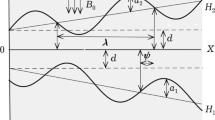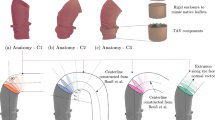Abstract
Blood flows with stenosis may cause turbulence. In such a case, vessels may be damaged by the turbulent flow because the velocity gradient of turbulent flow is large near the wall. It is very important to predict turbulence accurately. Generally, the shape of the stenotic vessel is quite complicated. Finite element method (FEM) is adopted because it is able to easily handle the stenotic vessel with unstructured meshes. Also, based on FEM, large eddy simulation (LES) is implemented to accurately solve turbulent flows in a vessel. To verify the accuracy of the LES technique developed, it is applied to the turbulent flow in an eccentric stenosis flow considered by Varghese et al. [1]. The simulation results showed that laminar flow occurs at the inlet region, whereas turbulence flow occurs after stenosis region. The present results show a reasonably good agreement with the DNS results of Varghese et al. [1].
Similar content being viewed by others
References
S. S. Varghese, S. H. Frankel and P. F. Fischer, Direct numerical simulation of stenotic flow: Part 1. Steady flow, J. Fluid Mech., 582 (2007) 253–280.
A. Pal, K. Anupindi, Y. Delorme, N. Ghaisas, D. A. Shetty and S. H. Frankel, Large eddy simulation of transitional flow in an idealized stenotic blood vessel: evaluation of subgrid scale models, J. Biomech. Eng., 136 (2014) 071009.
S. A. Berger and L.-D. Jou, Flows in stenotic flows, Annu. Rev. Fluid Mech., 32 (2000) 347–382.
S. A. Ahmed and D. P. Giddens, Velocity measurements in steady flow through axisymmetric stenoses at moderate Reynolds numbers, J. Fluid Mech., 16 (1983) 505–516.
M. D. Griffith, T. Leweke, M. C. Thompson and K. Hourigan, Effect of small asymmetries on axisymmetric stenotic flow, J. Fluid Mech., 721 (2013).
F. P. P. Tan, N. B. Wood, G. Tabor and X. Y. Xu, Comparison of LES of steady transitional flow in an idealized stenosed axisymmetric artery model with a RANS transitional model, J. Biomech. Engrg., 133 (2011).
P. F. Fischer, F. Loth, S. E. Lee, S.-W. Lee, D. S. Smith and H. S. Bassiouny, Simulation of high-Reynolds number vascular flows, Comput. Methods Appl. Mech. Engrg., 196 (2007) 3049–3060.
A. W. Vreman, An eddy-viscosity subgrid-scale model for turbulent shear flow: algebraic theory and application, Phys. Fluids, 16 (2004) 3670–3681.
M. H. Cho, H. G. Choi, J. Y. Yoo and J. I. Park, Study on the segregation algorithms of the incompressible Navier-Stokes equations using P1P2/P2P1 finite element formulation, Trans. of the KSME (B), 30 (2006) 262–269.
D. N. Ku, Blood flow in arteries, Annu. Rev. Fluid Mech., 29 (1997) 399–434.
K. M. Guleren, Numerical flow analysis of coronary arteries through concentric and eccentric stenosed geometries, J. Biomech, 46 (2013) 1043–1052.
J. Choi, M. H. Tawhai, E. A. Hoffman and C.-L. Lin, On intra- and intersubject variabilities of airflow in the human lungs, Phys. Fluids, 21 (2009) 101901.
H. Choi, S. Kang and J. Y. Yoo, Parallel large eddy simulation of turbulent flow around MIRA model using linear equal-order finite element method, Int. J. Numer. Meth. Fluids, 56 (2008) 823–843.
S. S. Varghese, S. H. Frankel and P. F. Fischer, Modeling transition to turbulence in eccentric stenotic flow, J. Biomech. Engrg., 130 (2008) 014503.
S. J. Sherwin and H. M. Blackbum, Three-dimensional instabilities of Steady and pulsatile axisymmetric in a closed stenotic flows, J. Fluid Mech., 533 (2005) 297–327.
J. Vetel, A. Garon, D. Pelletier and M. I. Farinas, Asysmmetry and transition to turbulence in a smooth axisymmetric constriction, J. Fluid Mech., 607 (2008) 351–386.
R. Gardhagen, J. Lantz, F. Carlsson and M. Karlsson, Quantifying turbulent wall shear stress in a stenosed pipe using large eddy simulation, J. Biomech. Engrg., 132 (2010) 061002.
Author information
Authors and Affiliations
Corresponding author
Additional information
This paper was presented at the 10th ACFD, Jeju, Korea, October 2014. Recommended by Guest Editor Hyoung-Gwon Choi
Byoung-jin Jeon received a Ph.D. at Seoul National University of Science and Technology majoring in computational fluid dynamics based on finite element method. He is currently a Post-Doc in the integrative cardiovascular imaging research center of Yonsei University.
Jungwoo Kim obtained his B.S., M.S. and Ph.D. degrees at the Department of Mechanical Engineering, Seoul National University, Korea, in 1999, 2001 and 2005. Dr. Kim is currently an assistant professor at the Department of Mechanical System Design Engineering, Seoul National University of Science and Technology.
Hyoung-gwon Choi received a Ph.D. at Seoul National University majoring in computational fluid dynamics based on finite element method. He is currently a professor in the department of mechanical engineering of Seoul National University of Science and Technology.
Rights and permissions
About this article
Cite this article
Jeon, B.J., Kim, J. & Choi, H.G. A finite element analysis of turbulent eccentric stenotic flows by large eddy simulation. J Mech Sci Technol 29, 1869–1874 (2015). https://doi.org/10.1007/s12206-015-0407-4
Received:
Revised:
Accepted:
Published:
Issue Date:
DOI: https://doi.org/10.1007/s12206-015-0407-4




